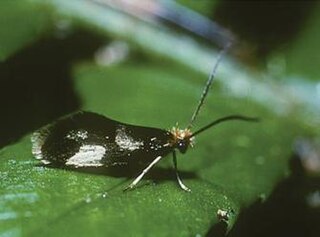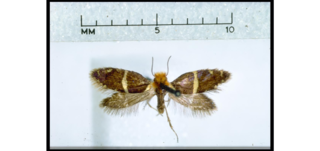
Micropterix aureatella is a moth of the family Micropterigidae found in the Palearctic realm, except for North Africa.

Micropterix mansuetella is a species of moth belonging to the family Micropterigidae and can be found in Europe, in very wet woodlands, fens and carrs. The imago was described by Philipp Christoph Zeller in 1844, but the larva and pupa are poorly described.

Sabatinca aurella is a species of moth of the family Micropterigidae. It is endemic to New Zealand. The larvae of this species are variable in appearance but tend to be coloured yellow-green with greyish patches. The adults of the species have a pale golden appearance with silver or purple coloured bars on the forewings. The moth has an approximate wingspan of around 1cm. This species is found from the Coromandel Peninsula to the Fox Glacier and is on the wing from September to January. A larval host species is the liverwort Heteroscyphus lingulatus. The preferred habitat of this species is at higher altitudes than other New Zealand endemic species in this genus; and the moth tends to prefer forest or subalpine grass or scrubland.

Sabatinca chalcophanes is a moth of the family Micropterigidae. This species is endemic to New Zealand and is found in the North Island apart from Northland and in the South Island apart from in the east, south of Queen Charlotte Sound. The adults of this species are on the wing from November to April and as a result of this long period it has been hypothesised that this species has two broods. The preferred habitat of this species is in damp lowland forest. The larval host species are foliose liverwort species including Hymenophyton flabellatum.

Zealandopterix zonodoxa is a moth of the family Micropterigidae. It is endemic to New Zealand and is located from Hawkes Bay north as well as on Poor Knights, Little Barrier and the Great Barrier Islands. It is the smallest micropterigid in New Zealand and the shiny white markings on the forewing of this species display variation. It is a moth that is active during the day, but has been collected using UV light. Adults are on the wing from September to March and the species has been witnessed visiting the flowers of Nīkau and Cordyline pumilio in large numbers. It inhabits a wide variety of moist indigenous forest but is associated with forests in which podocarps are common. Larvae have been sieved from rotten wood on the floor of a mixed podocarp/broadleaf forest or extracted from moss or from bryophytes.

Epimartyria is a genus of small primitive metallic moths in the family Micropterigidae.

Epimartyria auricrinella is a species of moth belonging to the family Micropterigidae. It was described by Lord Walsingham. It is known from the eastern parts of the United States as well as south-eastern Canada. Its MONA number is 0001.

Epimartyria pardella is a species of moth belonging to the Micropterigidae family. It was described by Walsingham, Lord Thomas de Grey, in 1880. Its wingspan is 10–11 mm with a metallic brown forewing featuring three distinctive gold spots. Adults are on wing from early May to mid July and are day active. The larvae feed on liverworts, including Conocephalum conicum and Pellia species and take about two years to fully develop.

Sabatinca doroxena is a species of moth belonging to the family Micropterigidae. It is endemic to the North Island of New Zealand. This small moth has a colourful forewing pattern with stripes and dots evident. It has been hypothesised that the forewing pattern is intended to resemble a jumping spider in order to allow the adult moth to escape predation. Adults of this species are on the wing from the beginning of September until mid January. It prefers damp but sunny habitat in deep forest, at the forest edge or in open shrubland. Larvae feed on foliose liverwort species including on Heteroscyphus normalis. Adults of this species have been located at the blossoms of flowering Cordyline and Ranunculus species.

Sabatinca ianthina is a species of moth belonging to the family Micropterigidae. It was described by Alfred Philpott in 1921. It is endemic to New Zealand. This species can be found on both the North and the South Islands from the Hawkes Bay down to Westland. The adults of this species are on the wing from the end of September until the middle of December. Although this species resembles Zealandopterix zonodoxa, S. ianthina is a larger moth and the range of the two species only overlaps in White Pine Bush Scenic Reserve in the Hawke’s Bay.

Sabatinca aemula is a species of moth belonging to the family Micropterigidae. It is endemic to New Zealand and is found in the north western parts of the South Island. The larvae of this species has yet to be collected but it has been hypothesised that the larvae subsist on foliose liverworts similar to other species in the Sabatinca genus. The adults of the species are on the wing from the middle of September until the end of December. The adults of S. aemula are very similar in appearance to S. chrysargyra and it has been argued they can only be distinguished by dissection. However more recent research suggests that the colour patterns on the forewings of the two species can be sufficient to distinguish between the two species.

Sabatinca caustica is a species of moth belonging to the family Micropterigidae. It was described by Edward Meyrick in 1912. It is endemic to New Zealand and is found in both Southland and at Stewart Island / Rakiura. The adults of this species are variable in appearance with some specimens being mainly white on their forewings while others have forewings that are a more mottled purple-brown colour. Adults are on the wing from the start of October until the middle of December. Larvae feed on the surface of leafy liverworts.

Sabatinca chrysargyra is a species of moth belonging to the family Micropterigidae. It was described by Edward Meyrick in 1886 and is endemic to New Zealand. It can be found from Franz Josef Glacier / Kā Roimata o Hine Hukatere south but only on the western side of the South Island. Adults are on the wing from the beginning of October until the middle of January. Larvae likely feed on foliose liverworts and have been found on species in the genus Plagiochila. The adult moths live in a range of habitats preferring sunny open spaces in forests or snow-tussock grasslands that can range in altitude from near sea level up to 1,230 m. This species is very similar in appearance to Sabatinca aemula and dissection of genitalia is required to distinguish between the two species.

Sabatinca demissa is a species of moth belonging to the family Micropterigidae. It is endemic to New Zealand and is found in the northern half of the North Island. The larvae of this species are small in size and are coloured pale green with darker green or black patches on the rear of its body. The adult moth is coloured yellow-brown with black dots on its forewings. It is a small moth with a wingspan of approximately 6.5 mm in length. Unlike many species of moth, it does not have a pheromone communication system. The adults of the species are on the wing from November to January. The larvae of this species feed on leafy types of liverwort. The adults of this species feed on the spores of fertile cones of Lycopodium volubile and Lycopodium scariosum.

Sabatinca heighwayi is a species of moth belonging to the family Micropterigidae. It was described by Alfred Philpott in 1927 and is endemic to New Zealand. It can be found north of Lewis Pass in the north west of the South Island. Adult moths are on the wing from late September until the middle of January. The host of the larvae of this species is the foliose liverwort Plagiochila circumcincta.

Sabatinca quadrijuga is a species of moth belonging to the family Micropterigidae. This species is endemic to New Zealand and is found in the Dunedin area and in Southland. The range of S. quadrijuga overlaps with the range of S. caustica.S. quadrijuga was first scientifically described by Edward Meyrick in 1912. As a result of its predominantly black forewings this species looks similar to a small caddisfly. The adults of this species are on the wing from September to November. Larvae feed on leafy liverwort species and the adults likely feed on fern spores or sedge pollen. The species prefers to live in well lit but damp mossy habitats. The nearest relative of S. quadrijuga is S. aurantissima.

Sabatinca calliarcha is a species of moth belonging to the family Micropterigidae. It was described by Edward Meyrick in 1912. It is endemic to New Zealand. It is found in two separate areas of New Zealand - the first in the northern parts of the North Island including Great Barrier Island and the second population can be found from the top of the South Island down to Southland. The adults of the species are on the wing from the end of September until the middle of January. The species prefers to inhabit damp forests and larvae likely feed on leafy liverwort species. Adult moths likely feed on the spores of ferns or the pollen of sedge grasses.

The shy cosmet moth is a moth of the family Cosmopterigidae. It is known from all of Europe, as well as Asia, Australia and New Zealand. It is also present in North America, where it is distributed from Nova Scotia to Virginia, west to Oklahoma and north to Ontario. The habitat consists of fens and marshes.

Aseptis fanatica is a moth of the family Noctuidae first described by Tomas Mustelin in 2006. It is found in western North America in Washington, Oregon, California, and Baja California Norte in Mexico. It is found in habitats like brush land and open forest in southern California, mostly at 1000–2000 meters, but occurs at lower elevations farther north.
Sabatinca weheka is a species of moth belonging to the family Micropterigidae. This species is endemic to New Zealand where it can be found near Lake Matheson and also on Secretary Island. This species is very similar in appearance to S. heighwayi in both their larval and adult forms but the adults of S. weheka differ as they are darker and more strongly marked on the forewings and have a dark brownish base colour to their wings. This species is on the wing from the middle to the end of October and lives in forest with a high rainfall. The larval host species is the liverwort Plagiochila deltoidea.




















